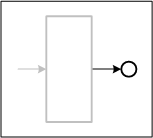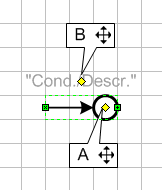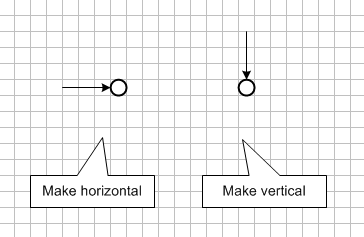 |
The End Place (horizontal and vertical connection) is useful for providing an output place for a Transition.
This shape is actually only a one-dimensional shape, i.e. an edge. Thus it is limited in its capabilites compared to a manually combination of a place and an edge (e.g. no definition of an arc-weight possible). Because there is only one connection point, no automatic layout is possible. |
 |
|
The context menu allows you to mark the place.
 |
Mark Place - If checked, a token will appear inside the place. |

The shape must be manually layouted (Note: There is no automatic layout available, because there is only one real connection point). To control the manual layout, use the context menu as well:

|
Make Horizontal - If automatic layout is turned off, you can manually set the shape to horizontal. | |
| Make Vertical - If automatic layout is turned off, you can manually set the shape to vertical. |

Depending on the layout, whether the End Place is horizontally or vertically, you can set the alignment. Accordingly there is always only one of the following shown in the context menu.

|
Align Top - The shape will be aligned at the top end-point. | |
| Align Center - The shape will be aligned at the center (always shown by the dotted line). | ||
| Align Bottom - The shape will be aligned at the bottom end-point. |

|
Align Left - The shape will be aligned at the left end-point. | |
| Align Center - The shape will be aligned at the center (always shown by the dotted line). | ||
| Align Right - The shape will be aligned at the right end-point. |
![]() Place
Place
![]() Edge (direct connection)
Edge (direct connection)
![]() Edge (horizontal and vertical connection)
Edge (horizontal and vertical connection)
![]() End Place (direct connection)
End Place (direct connection)